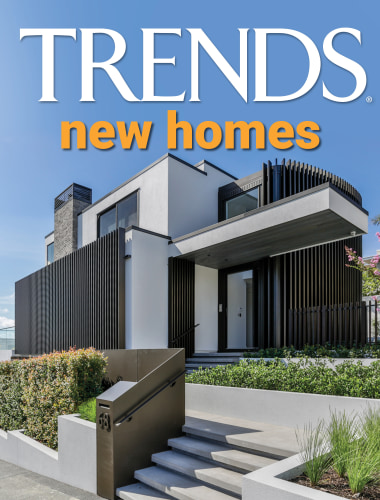A dynamic new home respects its natural setting in several ways
Standing tall amongst mature trees, this home on an awkward site, boasts simple, robust materials; an adroit layout, with minimal site disturbance; and several sustainable strategies
Designed by RAAarchitects
From the architects:
The house lies below street level to retain views over it from neighbouring houses.
Conceived as a treehouse with platforms taking shelter amongst the tree canopies, the volume floats over the terrain to minimise site disturbance and maximise daylight access and views.
The plan is a simple rectangle and a right-angle triangle, forming two separate roofs and two split-level living areas beneath.
The height and angle of the roofs create a complex and dynamic internal space emphasised by using a single material, birch ply, for internal walls and ceilings.
These floating roofs allow views of the surrounding trees and dappled light to enter the house and allow views through the house as you descend from the street.
The journey through the site starts at the heavy, partially cantilevered, off-form concrete garage, proceeds over rock ledges between twisted fig trees to the house.
Inside, the envelope gradually opens up to reveal the tree canopy above and distant views beyond. The culmination is the narrow, fragile point at the end of the deck where you are almost completely suspended in the sky.
Visual and spatial connection to the outside is a constant reminder of where the house sits, while a well-connected and dynamic layout encourage the interactions of the family members.
Traditional beachside holiday-home materials are employed throughout the project with steel framing, cement sheet external walls, metal roofing, plywood internal linings, and timber floors.
The simplicity of the materials is enhanced by the precision of the construction and detailing.
The house sits on the western slope of a wooded hill.
Despite the orientation, the heat-load is minimised due to the existing mature trees and passive solar design strategies such as large eaves and overhangs to northern and western facades, high performance glazing, and operable openings for cross ventilation.
The roof, the main source of heat gain, is heavily insulated.
The project incorporated passive and active sustainable design strategies from its conception. A 6.8 KW solar system powers an electric heat pump for heating and cooling.
The system is currently energy positive and is expected to remain so even with four full time occupants.
Natural ventilation is facilitated by a combination of high- and low-level windows. Small screened openings and large sliding low-e glazed doors allow the residents to control the amount of natural ventilation.
The owner’s passion for the project is clear from the quality of the construction and the investment in the long-term performance of the building. Passive and active sustainable design strategies were introduced from the project’s conception.
Significant challenges were overcome by the structural engineer to design a steel structure with few internal walls, clerestory windows and cantilevered balconies.
This beautifully built house is the product of a relatively small budget but a huge investment of time, care and commitment by the owner and builder.
Credit list
Cladding
Wallcoverings
Awards
Story by: Trendsideas
Photography by: Michael Nicholson
Home kitchen bathroom commercial design
From farmhouse to farmstead
Walk this way – garden pathways to lead your thinking
Water, water, not everywhere








